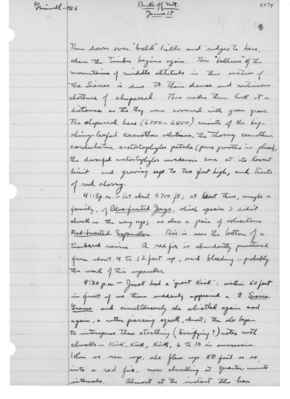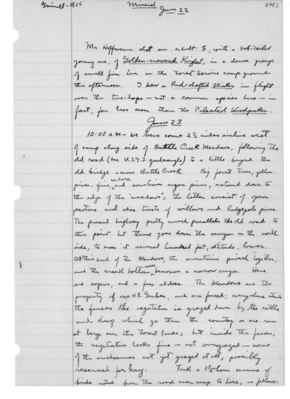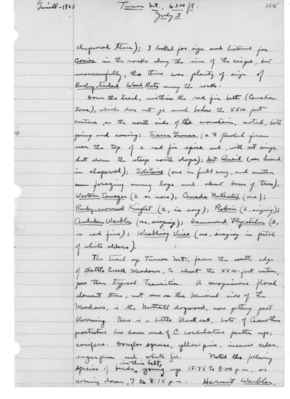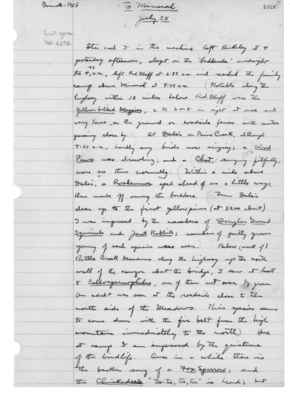Pages That Mention mountain
1925: Joseph Grinnell's field notes
S2 Page 19
Collector: Grinnell - 1925 Location: Lassen Section (Brokeoff Mt.) Date: June 17, 1925 Page Number: 2474
Then down over "bald" hills and ridges to here, where the Timber begins again. This "baldness" of the mountains of middle altitude in this section of the Sierras is due to their dense and continuous clothure of chaparral. This makes them look at a distance as tho they were covered with green grass. The chaparral here (6000-6500) consists of the big shiny-leafed ceanothus velutinus, the thorny ceanothus condulatus, arctostaphylos patula (pure growths in places), the dwarfed arctostaphylos nevadensis here at its lowest limit and growing up to two feet high, and tracts of red cherry. 4:15 p.m. - At about 6700 ft.; at least there, maybe a family, of Blue-fronted Jays, which species I didn't check on the way up; as also a pair of solicitous Red-breasted Sapsuckers. This is near the bottom of a timbered ravine. A red fir is abundantly punctured from about 4 to 12 feet up, and bleeding - probably the work of this sapsucker. 4:30 p.m. - Just had a "great kick": within 50 feet in front of us there suddenly appeared a female Sierra Grouse and simultaneously she whistled again and again, a rather piercing squall, almost; then she began to intersperse these startling (terrifying?) notes with clucks - kirk, kirk, kirk, 6 to 10 in succession. When we ran up, she flew up 80 feet or so into a red fir, now clucking at quarter-minute intervals. Almost at the instant the hen
S2 Page 38
Collector: Grinnell - 1925 Location: Mineral Date: June 22 Page Number: 2492
Mr. Hoffmann shot an adult male, with a bob-tailed young one, of Golden-crowned Kinglet, in a dense group of small fir here on the Forest Service camp ground this afternoon. I saw a Red-shafted Flicker in flight over the tree-tops - not a common species here - in fact, far less seen than the Pileated Woodpecker.
June 23 10:00 a.m. - we have come 2 1/2 miles airline west of camp along side of Battle Creek Meadows, following the old road (see U.S.G.S quadrangle) to a little beyond the old bridge across Battle Creek. Big forest trees, yellow pines, fir, cedars, and sometimes sugar pines, extend down to the edge of the "meadows"; the latter consist of open pasture and also tracts of willows and lodgepole pines. The present highway pretty much parallels the old road to this point but thence goes down the canyon on the north side, to cross it several hundred feet, altitude, lower. At this end of the Meadows, the mountains pinch together, and the creek bottom ^soon becomes a narrow canyon. Here are aspens, and a few alders. The Meadows are the property of one W. L. Gerber (?), and are fenced; everywhere astride the fences the vegetation is grazed down by the cattle and sheep which go thru [sic] the country or are seen at large over the forest lands; but inside the fences, the vegetation looks fine - not overgrazed - some of the enclosures not yet grazed at all, possibly reserved for hay. Took a 1 1/2 hour census of birds notes from the road near camp to here, as follows:
S2 Page 63
Collector: Grinnell - 1925 Location: Mineral, 4800 ft. Date: July 2 Page Number: 2516
we came. The four young are saved in formalin: 6282 Hammond Flycatcher, 4 small young under this number.
Other birds seen on the big meadow this forenoon were: Vaux Swift (3 flew close over the tree-tops); Tree Swallow (twittering young in company of adults were flying about over the open part of the meadow); Western Bluebird (a family on fence and in meadow).
July 3 5 p.m. - With the family on Turner Mountain, the highest elevation immediately south of Battle Creek Meadows - altitude "6300 feet", according to Mr. J.M. Stark, in winter a school-teacher in Corning, for the three summer months Forest Service Lookout on this Mountain. From here, we get a grand view (after a thunderstorm - 43 lightning strikes counted by Mr. Stark - earlier this afternoon) of Brokeoff Mt. and Mt. Lassen, and the vast surrounding timbered mountain mass. On the north side of this mountain is a perfect glacial cirque (a residual snow bank under its rim now) with a series of hummocky moraines, and two lakes impounded. A few scrub red firs and two or three alpine hemlocks and mountain pines straggle around the uppermost rim; below, around the lakes, are close stands of hemlock and lodgepole pines, the timber elsewhere above about the 5500 contour being red-fir. But the greater portion of the area in the vicinity of the top, is covered densely with chaparral. Right here on top this chaparral is wind-beaten but dense, and
S2 Page 65
Collector: Grinnell - 1925 Location: Turner Mt., 6300 ft. Date: July 3 Page Number: 2518
chaparral there); I looked for sign and listened for Conies in the rocks along the rim of the cirque, but unsuccessfully, tho there was plenty of sign of Bushy-Tailed Wood Rats among the rocks.
Down the trail, within the red fir belt (Canadian Zone), which does not go much below the 5500 foot contour, on the north side of the mountain, noted, both going and coming: Sierra Grouse (a [male symbol] flushed from near the top of a red fir spire and, with set wings, shot down the steep north slope); Mt. Quail (one heard in chaparral); Solitaire (one in full song, and another seen foraging among logs and about bases of trees); Western Tanager (2 or more); Canada Nuthatch (one); Ruby-crowned Kinglet (2, in song); Robin (2, singing); Audubon Warbler (one, singing); Hammond Flycatcher (2, in red firs); Warbling Vireo (one, singing in patch of white alders).
The trail up Turner Mt. from the south edge of Battle Creek Meadows, to about the 5500-foot contour, goes thru [sic] typical transition. A conspicuous floral element there, not seen on the Mineral side of the Meadows, is the Nuttall dogwood, now getting past blooming. There is a little black oak, lots of Ceanothus prostratus low down and of C. cordulatus farther up; conifers: Douglas spruce, yellow pine, incense cedar, sugar pine, and white fir. Noted the following species of birds ^in this belt, going up 12:45 to 3:00 p.m., or coming down, 7 to 8:15 p.m.: Hermit Warbler,
S2 Page 75
Collector: Grinnell - 1925 Location: To Mineral Date: July 25 Page Number: 2528
Last spec. no. 6292
Stu and I in the machine left Berkeley at 4 yesterday afternoon, slept on the "badlands" midnight to 4:45 a.m., left Red Bluff at 6:15 a.m. and reached the family camp above Mineral at 9:45 a.m. Notable along the highway within 12 miles below Red Bluff were the Yellow-billed Magpies, 2 to 6 or 8 in sight at once and very tame, on the ground or roadside fences with autos passing close by. At Dale's on Paine Creek, although 7:30 a.m., hardly any birds now singing; a Wood Pewee was drawling, and a Chat singing fitfully, more so than normally. Within a mile above Dale's, a Roadrunner sped ahead of us a little ways, then made off among the boulders. From Dale's clean up to the first yellow pines (at 3200 about) I was impressed by the numbers of Douglas Ground Squirrels and Jack Rabbits; numbers of partly grown young of each species were seen. Below (west of) Battle Creek Meadows along the highway up the north wall of the canyon about the bridge, I saw at least 8 Callospermophilus, one of them not over 1/3 grown. An adult was seen at the roadside close to the north side of the Meadows. This species seems to come down with the fir belt from the high mountain immediately to the north. Here at camp I am impressed by the quietness of the birdlife. Once in a while there is the broken song of a Fox Sparrow; and the Chickadee's "tee-tee, too, too" is heard; but




